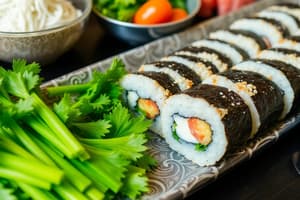Podcast
Questions and Answers
What was Yoshiaki's first material choice for the conveyor belt?
What was Yoshiaki's first material choice for the conveyor belt?
- Plastic
- Iron
- Wood and thick paper (correct)
- Stainless steel
Which shape did Yoshiaki use for the conveyor to better fit his restaurant's layout?
Which shape did Yoshiaki use for the conveyor to better fit his restaurant's layout?
- U-shaped (correct)
- Circular
- Square
- Straight
What was the ideal speed of the conveyor belt determined by Yoshiaki?
What was the ideal speed of the conveyor belt determined by Yoshiaki?
- 10 centimeters per second
- 8 centimeters per second (correct)
- 5 centimeters per second
- 12 centimeters per second
What problem did Yoshiaki face regarding the corners of the conveyor belt?
What problem did Yoshiaki face regarding the corners of the conveyor belt?
What aspect of chopstick use influenced Yoshiaki's decision on the conveyor belt's direction?
What aspect of chopstick use influenced Yoshiaki's decision on the conveyor belt's direction?
What inspired Yoshiaki to create the sushi train?
What inspired Yoshiaki to create the sushi train?
Which challenge did Yoshiaki NOT face while developing the sushi train?
Which challenge did Yoshiaki NOT face while developing the sushi train?
What material did Yoshiaki find to be the most effective for the conveyor belt after his trials?
What material did Yoshiaki find to be the most effective for the conveyor belt after his trials?
Flashcards are hidden until you start studying
Study Notes
Sushi Train Invention
- Yoshiaki Shiraishi invented the sushi train (kaiten zushi) in Osaka, Japan nearly 70 years ago.
- Yoshiaki was inspired by a tour of a bottling factory where he saw bottles moving along a conveyor belt.
- He encountered three main problems:
- Materials: He tried wood, thick paper, and iron, but these were not suitable for the constant cleaning. He finally settled on stainless steel.
- Corners: Right-angled corners led to plates getting stuck or falling off. He solved this by using half-moon shaped pieces of steel to create a "fan" shape around the corner.
- Speed: He found that a speed of 8 centimeters per second was ideal.
- The sushi train was designed to be in a "U" shape to fit Yoshiaki's restaurant and allow for the maximum seating capacity.
- The sushi train moves clockwise because most Japanese hold chopsticks in their right hand, allowing them to easily pull plates from the sushi train with their left hand.
Studying That Suits You
Use AI to generate personalized quizzes and flashcards to suit your learning preferences.




